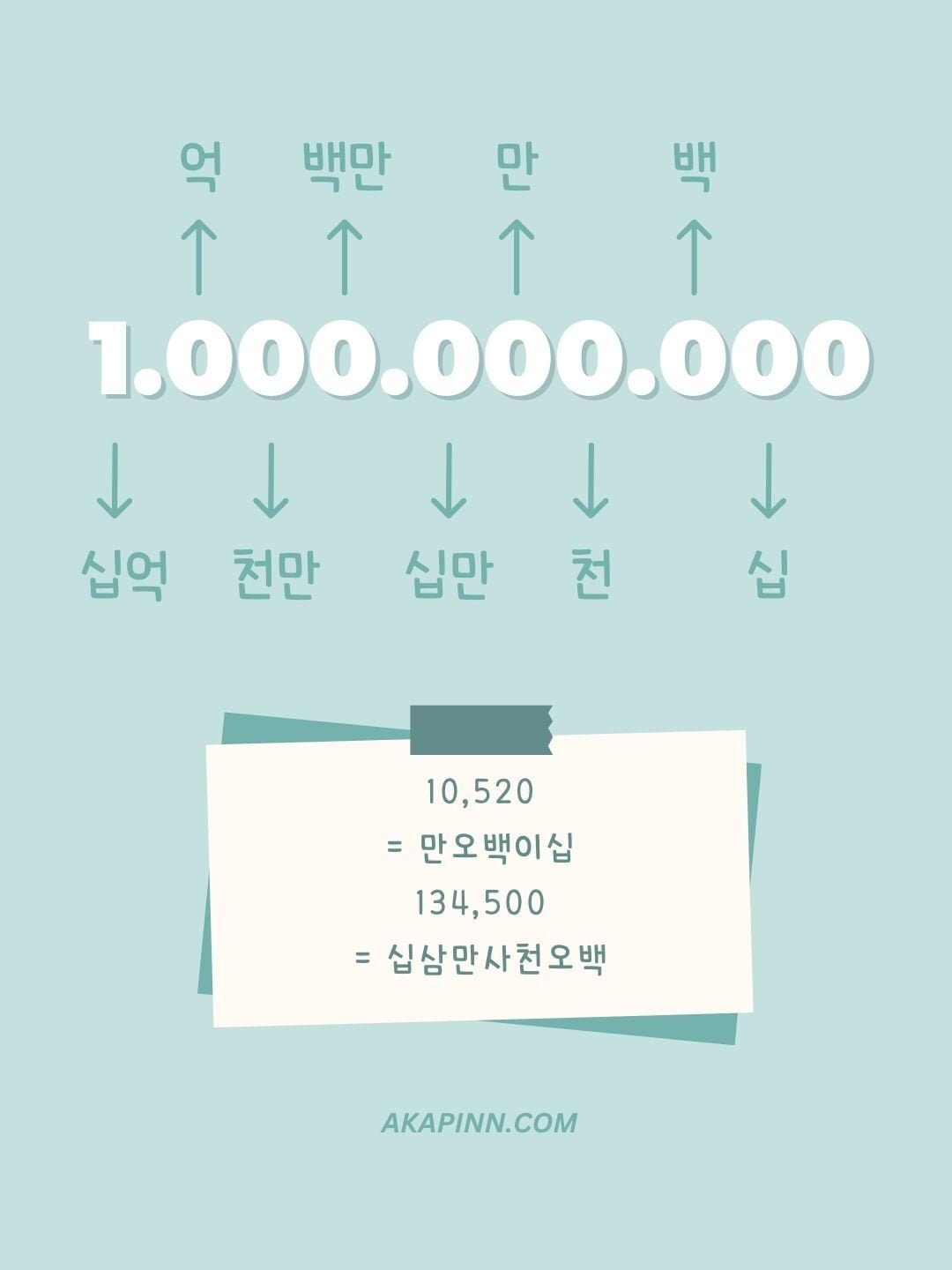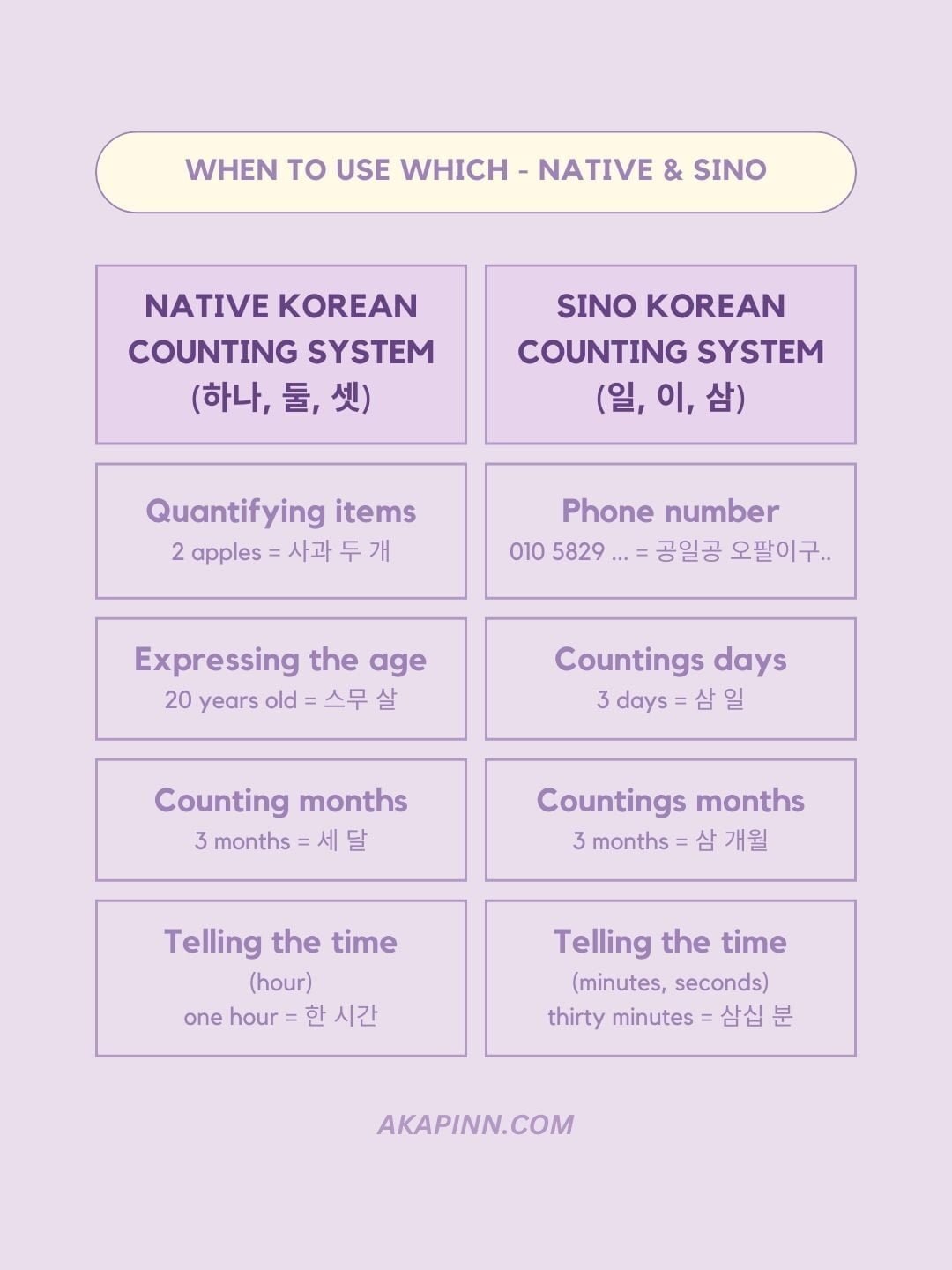So you’re learning Korean, and you finally face the numbers. Facing the Korean counting system might seem a bit daunting at the beginning. But don’t worry, it’s not that difficult when you get to learn it, use it, and get used to it. In this article, I’ll dive into both Korean counting systems.
We will break down the difference between the native Korean counting system, and the Sino-Korean counting system. We will also talk about the ways to use both, and check out situations where you can use them.
After reading about all of them, you should feel ready to use them with confidence! Let’s get started~
Table of Contents
- Counting in Korean
- The Native Korean number system
- The Sino-Korean number system
- The Usages for Both Korean Number Systems
- Wrap up
Counting in Korean
To count in Korean, you have two options.
- The Native Korean number system
- The Sino-Korean number system
Both systems are used in everyday life seamlessly and have particular usages that you have to get used to.
For example, you will use the Native Korean number system to tell the hour in the current time, but you will use the Sino-Korean number system to tell the minutes and seconds in the current time.
To illustrate the example, the current time is 1:47.
You will say: 한 시 사십칠 분 – where 한 comes from 하나 (native Korean number system), and 사십칠 comes from the sino-korean number system.
You have to learn the numbers, as well as the usages for each system.
You will also have to learn the counters in Korean to accompany these numbers.
In the example I just used, I wrote 시, and 분. These are called “counters”. The first one, 시, is used to count the hour. It can also be used as 시간 (three hours = 세 시간). The second one, 분, is used to count the minutes.
There are several counters for several type of objects/situations, and you will have to learn them as well.
It will seem a bit crowded at the beginning, but as time goes by, it will actually come very naturally to you and you won’t even have to think about it anymore.
Let’s dive into the Native Korean number system first!
The Native Korean number system
From 1 to 10
| Numbers | Native Korean |
| 1 | 하나 |
| 2 | 둘 |
| 3 | 셋 |
| 4 | 넷 |
| 5 | 다섯 |
| 6 | 여섯 |
| 7 | 일곱 |
| 8 | 여덟 |
| 9 | 아홉 |
| 10 | 열 |
Double Digits : From 20 to 99
| Numbers | Native Korean |
| 20 | 스물 |
| 30 | 서른 |
| 40 | 마흔 |
| 50 | 쉰 |
| 60 | 예순 |
| 70 | 일흔 |
| 80 | 여든 |
| 90 | 아흔 |
Examples Using the Native Korean System
43 = 마흔셋
11 = 열하나
74 = 일흔넷
82 = 여든둘
What About Large Quantities ?
For larger quantities, you won’t be using the Native Korean number system. You can use it up to 99. Starting from 100, you will have to use the Sino-Korean number system.
Example : 100 apples = 사과 백 개
The Counters With the Native Korean Numbers
When you use the Native Korean number system, you will have to use it with counters. Most of the item counters will be used with the Native Korean number system. But, and it’s important: some counters are also used with the Sino-Korean number systems.
To use the counter, you follow this rule:
item + number + counter
So if we follow this to say “two apples”, it goes like this :
item (apple) + number (two) + counter (개)
two apples = 사과 두 개
For this case, we used the counter “개“, but other items will use different counters. Here are some commonly used ones:
- 개
- Usage: Used for counting most objects without a specific counter.
- Example: 책 두 개 – Two books
- 장
- Usage: Used for counting flat objects such as paper, sheets, or documents.
- Example: 종이 다섯 장 – Five sheets of paper
- 병
- Usage: Used for counting bottles or containers.
- Example: 물 한 병 – One bottle of water
- 마리
- Usage: Used for counting animals.
- Example: 고양이 두 마리 – Two cats
- 명
- Usage: Used for counting people or individuals.
- Example: 학생 네 명 – Four students
- 대
- Usage: Used for counting machines, vehicles, or appliances.
- Example: 자동차 한 대 – One car
- 그릇
- Usage: Used for counting bowls or dishes of food.
- Example: 밥 다섯 그릇 – Five bowls of rice
- 살
- Usage: Used for counting years of age.
- Example: 열세 살 – Thirteen years old
Check everything about the Korean counters by reading this other post !
The Sino-Korean number system
The Sino-Korean number system is based on the Chinese characters. Before Hangul was created, Korean people were using Chinese characters, as you might have read in this article about Hangul. The Korean language is heavily influenced by the Chinese language, and numbers are a good example of that.
From 1 to 10
You don’t need to learn many numbers to be able to count perfectly with the Sino-Korean number system. First, let’s learn the Sino-Korean numbers from one to ten.
| Number | In Korean |
| 1 | 일 |
| 2 | 이 |
| 3 | 삼 |
| 4 | 사 |
| 5 | 오 |
| 6 | 육 |
| 7 | 칠 |
| 8 | 팔 |
| 9 | 구 |
| 10 | 십 |
Forming Double Digits Numbers with the Sino-Korean System
When you know this, you can form any double-digit number in Korean, by following a rule :
number + 십 + number
For example, you want to say “23”. You take the first number (2), you make 20 with it by adding “십“, then 3.
2 + 10 + 3 => 이 + 십 + 삼
23 = 이십삼
Another example: you want to say “57”. You take the first number (5), you add “10”, then 7.
5 + 10 + 7 => 오 + 십 + 칠
57 = 오십칠
So, as you might have understood with this rule, making 20, 30, 40, 50… is easy :
| Number | In Korean |
| 10 | 십 |
| 20 | 이십 |
| 30 | 삼십 |
| 40 | 사십 |
| 50 | 오십 |
| 60 | 육십 |
| 70 | 칠십 |
| 80 | 팔십 |
| 90 | 구십 |
The Larger Number Units
The rule I’ve just taught you for double digits works the same way for larger number units in Korean. You only need to remember each number units. Right now, you’ve learned that 10 is 십. Now, you need to know 100, 1000, 10000.
| Number | In Korean |
| 100 | 백 |
| 1000 | 천 |
| 10 000 | 만 |
| 100 000 | 십만 |
| 1 000 000 | 백만 |
| 10 000 000 | 천만 |
| 100 000 000 | 억 |

Forming Larger Numbers with Sino-Korean System
The rule is that you need to place the unit according to the numbers while following the rule given previously. The larger the number, the more number units you will have to insert. It’s easier to understand with examples, so let’s get right into it.
(larger number units) + number + 십 + number
Saying 110 in Korean
In 110, you have the number digit for 100, and for 10.
=> 백십 (100 + 10)
Saying 353 in Korean
In 353, you have the number digit for 100, and for 10 as well.
=> 삼백오십삼 (3 + 100 + 5 + 10 + 3)
The same goes for even larger numbers.
Saying 1397 in Korean
In 1397, you have the number digit 1000, 100 and 10.
=> 천삼백구십칠 (1000 + 3 + 100 + 9 + 10 + 7)
The 10 000 increments : 만
Something to be aware of when counting in Korean is the increment 만. In English, we use increments of 1000.
=> 1000 (thousand), 10000 (ten thousand), 100 000 (hundred thousand)
In Korean, we use increments of 10.000 (만)
=> 10.000 (만), 100.000 (십만), 1.000.000 (백만), 10.000.000 (천만) and then the next increment, 억 for 100.000.000.
The Counters With the Sino-Korean Numbers
As I said previously, some counters are used with the Sino-Korean number system. I will give you some examples that you can remember about.
- 년
- Usage: Used to count years
- Example: 이년 – Two years
- 일
- Usage: Used to count days
- Example : 삼일 – Three days
- 분
- Usage : Used to count minutes
- Example : 오분 – Five minutes
- 초
- Usage : Used to count seconds
- Example : 십초 – Ten seconds
Check everything about the Korean counters by reading this other post !
The Usages for Both Korean Number Systems
Now that you know everything about both counting systems, you need to know how and when to use them.
Native Korean numbers usages
- Quantifying items
- Expressing the age
- Counting months
- Telling the time (hour)
Sino-Korean numbers usages
- Money
- Counting days (days, years). Months can be counted with it as well.
- Dates
- Telephone numbers
- Addresses

Wrap up
You know now how to count in Korean ! Feel free to come back to this article to review some aspects of it, I know it’s not easy to remember about all of it at once. Take your time, make your own sentences and get used to this new system of counting. Happy learning~




